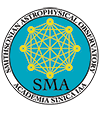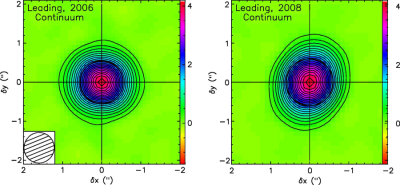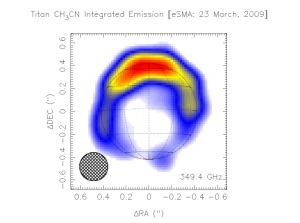 |
|
|
|
Solar System Science with the SMA
| ||||||||||||
|
Solar System Research Projects with the SMA
Venus - Measurement of thermal structure and winds in the mesosphere using dual-band observations of CO (Gurwell, 2007; Sagawa, 2009)
Ceres - Observations of nearly one full rotation, showing almost no variation in brightness temperature with longitude, and thus a very uniform surface in both mm and OIR bands (Moullet & Gurwell, 2009)
Jupiter - Imaging of remnant HCN (2007) and CS (2008) in the stratosphere from the 1995 Comet Shoemaker-Levy impacts, showing evolution of distribution and effects of polar vortices where material is dragged into troposphere (Moreno, 2007, 2008)
Saturn - Detection and imaging of CO in the upper atmosphere of Saturn (Cavalie et al 2010)
Io - Imaging the spatial extent of the weak atmosphere of Io, including SO, SO2, and NaCl distributions and implications for the relative strengths of direct volcanic and sublimation processes (Gurwell, 2006; Moullet & Gurwell, 2008)
Galilean Moons - Measurement of limb darkening and polarization properties, which can be tied to dielectric properties and density, leading to a better understanding of surface composition (Moullet & Gurwell, 2009, 2010)
Titan - Groundbreaking study on the vertical distributions of CO, HCN on Titan, along with isotopic ratios of 12C/13C (CO, HCN), 14N/15N (HCN), 16O/18O (CO) (Gurwell, 2004, 2008);- high resolution pathfinder study of the spatial distribution of CH3CN using the eSMA (Gurwell & Moullet, 2009)
Uranus - High resolution continuum imaging showing that the observed disk is warmer in polar relative to equatorial regions (Hofstadter 2006)
Neptune - High resolution spectroscopic imaging of CO and HCN in the atmosphere (in queue, not yet attempted) (Moullet & Gurwell, 2010)
Pluto - The first ever true thermal imaging that separate Pluto and Charon, which prove Pluto, at 40 K, is colder than the expected equilibrium temperature at 30 AU, a result of sublimation of N2 ices into the Plutonian atmosphere (Gurwell & Butler, 2005; Gurwell Butler & Moullet 2010)
Comet Studies - Several projects have been advanced led by C. Qi, including observations of C/Linear 2002 T7 (2004, CS, CH3OH detected), 9P/Tempel 1 ("Deep Impact". 2005, no detection of impact), 73P/Schwassmann-Wachmann 3 (2006, HCN jet activity detected), and 17P/Holmes (2007, HCN, CO, CH3OH, H2CO, H13CN, CS and jet activity detected)
M. A. Gurwell, Submillimeter Observations of Titan: Global Measures of Stratospheric Temperature, CO, HCN, HC3N, and the Isotopic Ratios 12C/13C and 14N/15N, 2004, ApJ, 616, L7
M. A. Gurwell, G. J. Melnick, V. Tolls, E. A. Bergin, B. M. Patten, SWAS Observations of Water Vapor in the Venus Mesosphere, 2007, Icarus, 188, 288
K. J. Meech et. al., Deep Impact: Observations from a Worldwide Earth-Based Campaign, 2005, Science, 310, 265
A. Moullet, M. A. Gurwell, E. Lellouch, R. Moreno, Simultaneous mapping of SO2, SO, NaCl in Io's atmosphere with the Submillimeter Array, 2010, Icarus, 208, 353
A. Moullet, M. Gurwell, B. Carry, Thermal rotational lightcurve of dwarf-planet (1) Ceres at 235 GHz with the Submillimeter Array, 2010, A&A, 516, 10
| ||||||||||||
|
|


